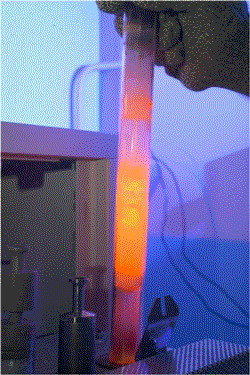
Photo: Picture of the vials used at ILSA to evaluate the nitrogen supply curves
L’aggiunta al suolo di sostanza organica attraverso la concimazione è una pratica agricola di fondamentale importanza per conservare e/o ripristinare la fertilità dei terreni coltivati.
La sostanza organica apportata subisce nel suolo un processo di degradazione di natura prettamente biologica, attraverso il quale si ha la trasformazione delle forme organiche degli elementi nutritivi (Azoto, Fosforo e Zolfo) a quelle inorganiche. Il processo è conosciuto anche come mineralizzazione della sostanza organica ed è regolato da numerosi fattori di natura chimica, fisica e microbiologica.
La conoscenza precisa di questo processo è di fondamentale importanza per una corretta gestione della concimazione, sia dal punto di vista agronomico (razionalizzazione dell’epoca di somministrazione delle dosi da applicare) sia ambientale (ad esempio per la riduzione delle perdite di nitrati per lisciviazione).
Another distinctive feature of AGROGEL® is that of having a significant amount of protein nitrogen. However, not all proteins mineralize at the same speed in the soil: the speed, under the same environmental conditions, crucially depends on the molecular complexity of the various proteins.
The nitrogen found in the complex protein structures of collagen may be available for vegetal uptake only after the mineralization processes of organic matter Therefore, this N fraction in the soil is naturally slow-release; in fact, its release is closely related to the natural processes induced by the microbial population.
In addition, the mineralization rate and the subsequent availability of assimilable nitrogen in the soil are not constant throughout the year because they are, among other parameters, strongly influenced by temperature and soil water content.
The slow-release fertilizers allow then reducing losses by leaching by gradually providing the nitrogen required by crops throughout the entire vegetative cycle, thus contributing to improving the nitrogen balance of the soil.
To better understand the action of the products in the soil and the dynamics of nitrogen release, ILSA has developed a method for assessing mineralization curves.
Nitrogen mineralization is a natural process that converts organic nitrogen into organic forms of ammoniacalnitrogen (NH4+) and nitric nitrogen (NO3-), which are those used by plants. This process is performed by soil microorganisms, and the metabolites (nitric and ammoniacal N) are the product of the decomposition of organic matter.
The nitrogen that can be mineralized is then determined in the laboratory, after incubation for 1, 2, 4, 6, 8, 10 and 14 weeks. The method involves soil incubation under controlled conditions of temperature and humidity.
The inorganic forms of ammoniacal and nitric nitrogen produced during incubation are extracted and determined by a colorimetric method.
The mineralization curve represents then the release of nitrogen that can be mineralized over time.
Cumulative curve of apparent mineralization after 75 days (product: Fertil)
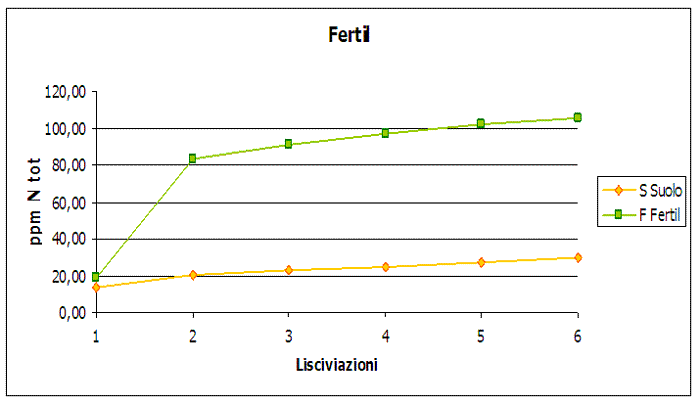
In Chart one can see the cumulative curve of the product Fertil and soil. The apparent cumulative curves are progressive curves, which also take into account the nitrogen supply from the mineralization of soil organic matter. Each point corresponds to a leaching and the interval is 15 days.
The test was performed at constant temperature and % on field capacity (water level in the soil), using a mixture of sandy soil and technical quartz sand.
Specifically:
-
- Temperature of incubation: 23°C
- Water retained: 50% of field capacity
- Period of incubation: 12 weeks
- Number of leachings: 6 (every 2 weeks)
- Soil: sandy mixed with quartz sand (1:1 ratio)
- Nitrogen applied: 100 mg N per kg of soilLooking at the curve one can see that there is a significant N release on the 15th day, and then a gradual release of N over time is shown, which is the typical behavior of the matrix AGROGEL®. The product Fertil proves then to be slow release in a totally natural way.
Cumulative curve of apparent mineralization after 75 days (product: Professional N)
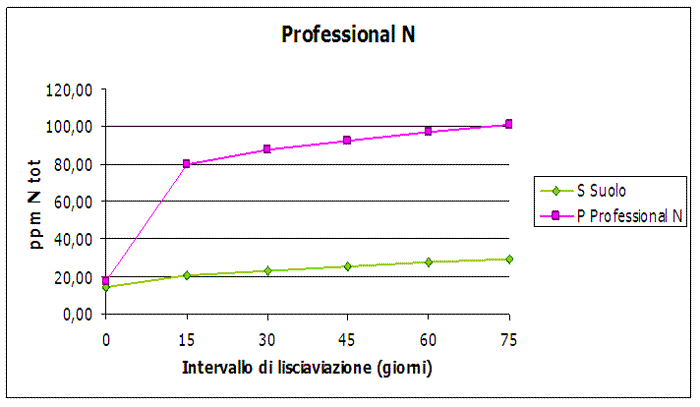
In chart one can see the cumulative curve of the product Professional N and soil. The apparent cumulative curves are progressive curves, which also take into account the nitrogen supply coming from the mineralization of soil organic matter. Each point corresponds to a leaching and the interval is 15 days.
The test was performed at constant temperature and % on field capacity (water level in the soil), using a mixture
of sandy soil and technical quartz sand.Specifically:
- Temperature of incubation: 23°C
- Field capacity: 50%
- Period of incubation: 12 weeks
- Number of leachings: 6 (every 2 weeks)
- Soil: clayey mixed with quartz sand (1:1 ratio)
- Nitrogen applied: 100 mg N per kg of soil
Looking at the curve one can see that there is a significant N release on the 15th day, and then a gradual N release
over time is shown, which is typical of the matrix AGROGEL®. So, the product Professional N also proves to be slow release in a totally natural way.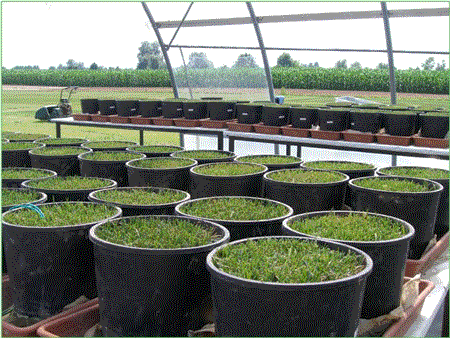
Photo: Picture of the vessels used in Quinto (Italy) to evaluate nitrogen release curves.
Besides the mineralization curves in the laboratory, where only the soil system is reproduced, at the experimental station of Quinto Vicentino (Vicenza, Italy) mineralization curves are measured directly using plants as a measuring instrument, in order to correlate the nitrogen released with what the plant actually “sees”.
The mineralization curves are then drawn by evaluating the cumulative dry biomass on model plants, generally perennial grasses such as Festuca arundinacea and Poa pratensis.
The relief of the biomass consists of a cut made at 20 mm.
Cumulative biomass curve – using perennial grasses as a model plant.
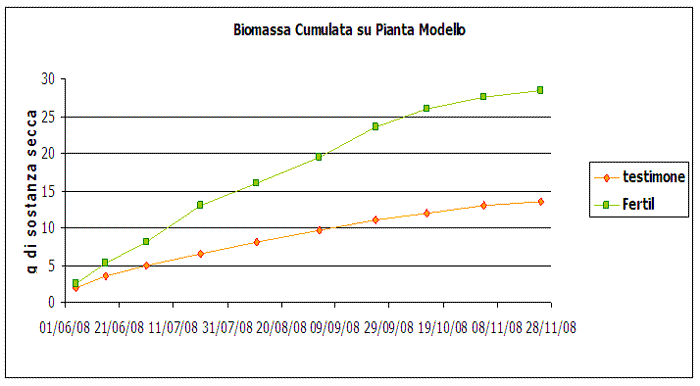
Perennial grasses (different species) are plants often used to “trace” the release dynamics of nutrients by fertilizers. This is because they, in spite of being subject to frequent cuts, with biomass removal, for many months or years, reconstitute rapidly their above-ground (foliar) mass after each cut without damage.
This makes it easy to trace the “cumulative curve of fresh and dry biomass” from every cut, and this may be placed in direct relation with total fertility, which is derived from the sum of the fertility made available by the soil and that from the fertilizer.
The fertilization with slow release products becomes, therefore, an indispensable tool to meet the production needs of the crop and to replenish the soil nitrogen reserves.
by the crop.Using the AGROGEL® AGROGEL®-based products, fertilization is streamlined and optimized, and so are avoided economic losses and risks of environmental pollution related to nitrogen losses in the atmosphere or water.To rationalize and optimize nitrogen fertilization means, in essence, improving the use efficiency of the fertilizer.
